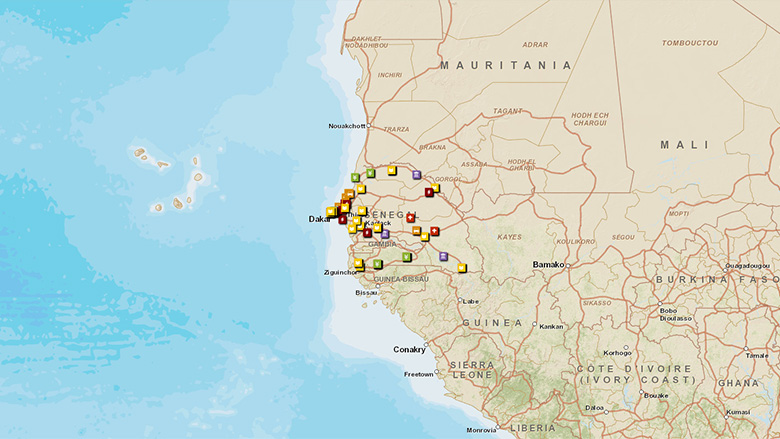Challenge
With 58 percent of its population living in rural areas, Senegal suffers from acute rural poverty. Sixty percent of this rural population derives its livelihood from agriculture, where smallholder producers cultivate rainfed crops and practice animal husbandry. As of 2006, the sector had stagnated due to limited access to knowledge, inputs, and working capital; soil fertility degradation; decreasing quality of seed stock; limited diversification and intensification; and gender inequalities. The first Agricultural Services and Producer Organizations Program (PSAOP) helped implement the Government of Senegal’s strong commitment to rural agricultural development, building institutional foundations for sectoral interventions and a network of producer organizations and advisory services in 142 of Senegal’s 320 rural council areas. Nevertheless, 178 areas were left without such services, agricultural productivity remained low, and many households were food insecure.
Solution
The PSAOP2 aimed to provide producers with agricultural services that would facilitate use of innovations for increasing agricultural productivity and food security, particularly among smallholder producers. The project strengthened the institutional framework established by the PSAOP, extended the coverage of agricultural advisory services, supported the emergence of private service providers, strengthened research capacity and focus, and empowered producer organizations. The National Agricultural and Agro-Processing Research Fund was bolstered and scientific capacity in the national agricultural research system was upgraded. The National Rural and Agricultural Advisory Agency advisory service was expanded to all 320 rural communities and the provision of agricultural advisory services was increased. Producer organizations were strengthened to improve social representation, garner producer participation in policy formulation, and enhance technical and economic capacity of smallholders. Finally, the Ministries of Agriculture and Livestock were strengthened to provide improved policy formulation, planning, coordination, monitoring, and evaluation of resource use.
Results
The project helped to increase smallholder producers’ access to sustainable and diversified agricultural services and innovations with the intention of increasing agricultural productivity and increasing food security. Specifically:
- 85 percent of producers were satisfied with the advisory services contracted
- 72 percent of producer organizations participating in the first PSAOP have adopted and integrated at least one innovation
- 62 percent of producers supported by the PSAOP2 saw their food security improve
- Average household agricultural production increased from 1.60 tons in 2008 to 3.06 tons in 2010
- Productivity increased from 0.26 tons per hectare in 2008 to 0.43 tons per hectare in 2009
- Overall, the PSAOP2 stimulated average household increases of cropped area by 29 percent, total production by 11 percent, auto-consumption by 42 percent, and commercialization of production by 78 percent
- New tomato varieties, such as Nadira and Flamenco, were adopted over 2,500 hectares throughout the Senegal River Valley yielded more tons per hectare
- Smoked fish residue was introduced as biologic fertilizer, increasing peanut grains yield by 37 percent, beans by 34 percent, millet by 55 percent, and sorghum by 35 percent
- New sweet potato varieties, such as 2544 and Fanaye, were adopted across the Senegal River Valley, increasing yields from 20 tons per hectare to 40-60 tons per hectare.
Bank Group Contribution
The International Development Association contributed $20 million to the project. Approximately $5.5 million supported the Agricultural Research System, $4.7 million supported extension of agricultural advisory services, $5 million supported producer organizations, and $4.2 million supported sectoral coordination.
Partners
There were a number of partners that served as implementing agencies:
- Senegal Ministries of Agriculture and Livestock
- Association for the Promotion of Senegalese Development
- National Agricultural and Agro-Processing Research Fund
- National Rural and Agricultural Advisory Agency
- Senegal Institute of Agricultural Research
Additionally, the Government of Senegal, the International Fund for Agricultural Development, and local farmer organizations contributed financing to the project.
Moving Forward
The government has not requested funding for a third phase of the PSAOP, but some of the institutional reforms generated by the program’s first two phases will continue to be supported by the World Bank’s West Africa Agricultural Productivity Program.
Beneficiaries
Mrs. Faty Abdoul Ba, a unit manager of a soap processing company, reports “We have been trained for two months in Matam (northern Senegal). We learned how to manage a small business, how to make good investments in order to make a profit. Initially, we wanted to buy and sell any kind of materials, but we did not have the money to do a first investment of FCFA 10 million. Finally, we opted for the manufacture of soap. We have been trained and we invested FCFA 200,000 and now we have tripled our production and clientele is vast in all villages around here.”
